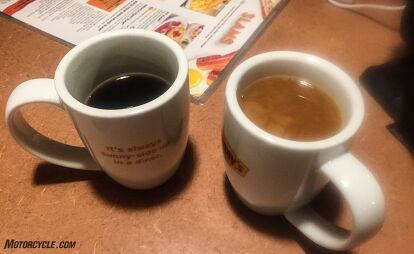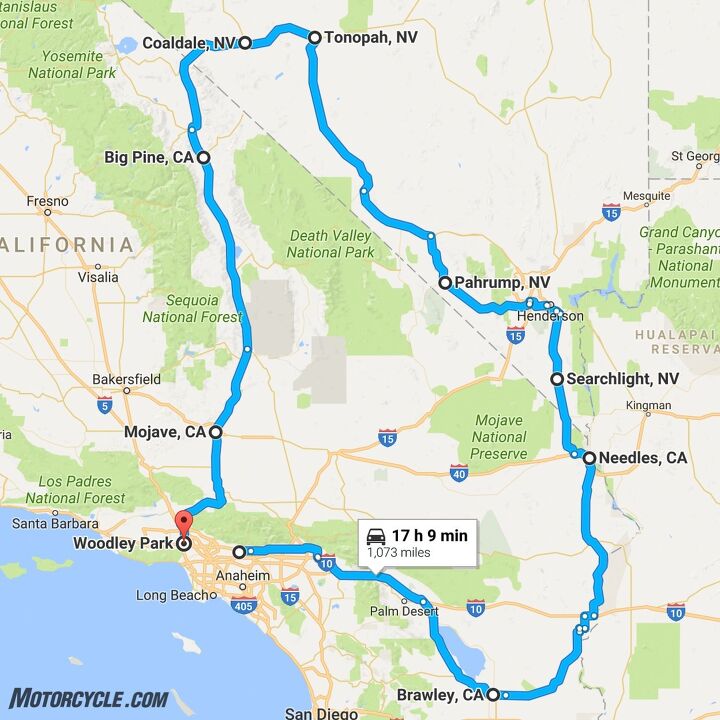Five Steps To Prepare For Your First Iron Butt

If you're going to do something foolish, jump in with both feet
Spring is springing like an underdamped shock absorber, and the heart of the riding season – with its long days and warm nights – is just around the next corner. So, why not make 2021 the year you do something epically MOronic? Grab a riding buddy, or two, and experience the Iron Butt Association‘s Saddlesore 1000, the gateway drug to long-distance motorcycle riding. Even if you only do it once, you’ll be able to regale your friends with stories from the time you rode your motorcycle 1000 miles in less than 24 hours. (Or maybe you were really feeling your oats and cranked out a Bun Burner 1500.
American Iron Butt: Conquering A SaddleSore 1000
While you may be able (and lucky enough) to simply pick a weekend to jump on your bike and ride those 1000 miles without any forethought, the rest of us would benefit from planning, particularly if your intended route takes you into remote parts of the country in the middle of the night. Not every gas station is fully automated or open 24 hours, and it would be a bummer to have your SaddleSore 1000 scuttled due to a lack of fuel.
So, read on to learn the five things that we learned during our own Saddlesore 1000.
1. Thoroughly plan your route
Map people will love this part. You need to plot your complete route for the 1000+ miles (to have a buffer to account for speedometer error). Once you have your route roughly planned out, go back through it and mark your gas stops, based on your bike’s range. In states with wide open spaces, like in the Southwest, you may have a relatively short stint before one that could tax your bike’s limits. As you are plotting your gas stops, also consider the time of day and when you may need to stop for food. In my experience, the middle of the night and around dawn are ideal rest/meal stops to combat fatigue and stay sharp. The rest of the time, make your gas stops as efficient as possible.
2. Do your research
Look at every feature of your intended route. We had to change our plans because of snow a couple days before we planned on traversing an 8,000-ft pass in the middle of the night. (It was February, after all.) Consider the time of day that you’ll be traveling through an area. Thanks to the internet, you can find all the stations in each town and even ascertain that they’ll be open when you’re scheduled to pass through.
3. Use a GPS and a tracker
While I count myself among those who love reading and using maps, a GPS is a vital tool on an Iron Butt ride. You can program in your route and make the gas stops waypoints so that you don’t make any silly mistakes when you ride. Also, you can use your GPS to save your track as a means of verifying your route to the Iron Butt Association. Should you encounter unexpected construction or road closures, the GPS can still get you to your next gas stop if you follow an extended detour. Finally, having your GPS remind you of upcoming turns is extremely helpful when you’re tired late in the ride. Note: Unless you have an app that features downloadable maps, it’s better to use a dedicated GPS rather than a smartphone since you are likely to spend time out of cell service.
Your friends and loved ones will want to follow your progress, particularly through the night. While there are smartphone apps you can use, I’m a big fan of Spot trackers. If buying and subscribing to their service is too expensive for you, consider renting one. In addition to tracking (and documenting for Iron Butt certification) your progress, you have the ability to send pre-programmed messages to your contacts from along the route from the array of buttons on the Spot. If an emergency arises, you can summon help to your location with the push of a button.
4. Carry your own provisions
The key to a successful Iron Butt ride is keeping the stops short. That way, you can build up a buffer of time for unexpected delays on your route. If you carry your own snacks and easy-to-eat meals with you, you can fuel yourself and the bike at the same time. While it’s easy to buy fluids at gas stations, healthy food is more difficult to acquire. Believe it or not, you’re stressing your body during endurance rides, so you’ll want to avoid heavy, fatty foods and stick to items that will be easy to eat and deliver maximum nutrition.
Avoid caffeine, at least in the early hours of your ride. If you don’t, you could use up its limited boost and hit a wall later in the trip, and caffeinated drinks may not be able to pull you out of it. When riding through hot weather, carry a hydration pack. You don’t want to drink so much that you need to pee every hour, but your concentration is the first thing to go when you get dehydrated.
If you build up a buffer of time thanks to efficient gas stops, you’ll be able to enjoy the luxury of a restaurant meal along the road when you really need it.
5. Listen to your body
Only you can decide if you’re too tired to ride, and you need a short break. More than once, I’ve hit the afternoon doldrums on an extended ride and achieved quick recovery with a 20-minute nap, leaned back on my bike, parked in the shade. The fun of endurance riding comes from completing the event. Don’t risk falling asleep at the handlebars and crashing. If you’ve got time in your pocket, get off the bike at a gas stop and move around a little to get the blood circulating.
If you’ve never ridden long distances before, don’t jump into the deep end of the pool not knowing how to swim. Take some longer rides to build up to an Iron Butt. Yes, you are just physically sitting on a bike, but riding is tiring. Rack up some 300-500 mile days before you attempt a Saddlesore 1000.
For more information on riding Iron Butt challenges, look to the Iron Butt Association website and it’s very informative forum.
We are committed to finding, researching, and recommending the best products. We earn commissions from purchases you make using the retail links in our product reviews. Learn more about how this works.
Become a Motorcycle.com insider. Get the latest motorcycle news first by subscribing to our newsletter here.

Like most of the best happenings in his life, Evans stumbled into his motojournalism career. While on his way to a planned life in academia, he applied for a job at a motorcycle magazine, thinking he’d get the opportunity to write some freelance articles. Instead, he was offered a full-time job in which he discovered he could actually get paid to ride other people’s motorcycles – and he’s never looked back. Over the 25 years he’s been in the motorcycle industry, Evans has written two books, 101 Sportbike Performance Projects and How to Modify Your Metric Cruiser, and has ridden just about every production motorcycle manufactured. Evans has a deep love of motorcycles and believes they are a force for good in the world.
More by Evans Brasfield











































Comments
Join the conversation
Step 1. Re-evaluate your life choices.
Step 2. Seek help.
Step 3. Get rid of that POS BMW you own. Get a real bike.
Step 4. Not a Bimmer? It's worse than we thought. Get rid of the Lead Wing or the HD.
Step 5. Get a life.
The most miles I put on in a day was Van Horn, Texas to San Diego, California. I left Van Horn around 5am and arrived San Diego at 12:30 pm.
Rode straight through except for breakdowns. (The bike was a 1968 Sportster)